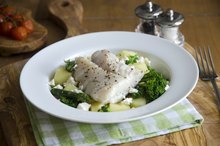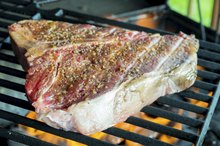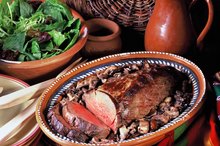What does fact checked mean?
At Healthfully, we strive to deliver objective content that is accurate and up-to-date. Our team periodically reviews articles in order to ensure content quality. The sources cited below consist of evidence from peer-reviewed journals, prominent medical organizations, academic associations, and government data.
The information contained on this site is for informational purposes only, and should not be used as a substitute for the advice of a professional health care provider. Please check with the appropriate physician regarding health questions and concerns. Although we strive to deliver accurate and up-to-date information, no guarantee to that effect is made.
The Nutritional Information for Pork Country Style Ribs
Country-style pork ribs come from a succulent cut of pork taken from the shoulder area of the pig 1. The ribs can be served with or without the bone, and country-style ribs tend to have a higher fat content than other cuts of pork 1. Pork is generally leaner than beef, and provides several vitamins and minerals that can help you meet your nutritional needs.
Calories and Servings
A 3 oz. serving of country-style pork ribs contains 270 calories 1. Of these 270 calories, about 189 are from fat. One serving of country style pork ribs accounts for about 14 percent the daily calories in a 2,000 calorie diet 1. Your caloric needs may be higher or lower than the average adult, depending on your activity level, and you can calculate your daily caloric requirements using an online calculator.
Fat and Cholesterol
Nutritional Values of Meat & Fish
Learn More
A serving of country-style pork ribs contains about 21 g of fat, 7 g of saturated fat and 75 mg of cholesterol 1. Most adults who eat a 2,000 calorie daily diet need about 44 to 78 g of fat each day. Excess saturated fat and cholesterol can be harmful to your cardiovascular system, and you should restrict your daily intake of each to about 15 g and 300 mg, respectively.
- A serving of country-style pork ribs contains about 21 g of fat, 7 g of saturated fat and 75 mg of cholesterol 1.
- Excess saturated fat and cholesterol can be harmful to your cardiovascular system, and you should restrict your daily intake of each to about 15 g and 300 mg, respectively.
Sodium
A 3 oz. serving of country-style pork ribs contains about 65 mg of sodium, or about 2 percent the daily value for this mineral 1. A small amount of sodium in the diet can help regulate nerve impulses and muscle contractions, as well as control the body's fluid balance. Too much sodium, however, can result in high blood pressure and cardiovascular problems. Limit your sodium intake to 1,500 mg a day.
- serving of country-style pork ribs contains about 65 mg of sodium, or about 2 percent the daily value for this mineral 1.
- A small amount of sodium in the diet can help regulate nerve impulses and muscle contractions, as well as control the body's fluid balance.
Protein
Vitamins & Minerals That Meats Give Us
Learn More
Country-style pork ribs are a rich source of protein, with about 19 g per 3 oz 1. serving. Protein should account for about 10 to 15 percent of your diet, so if you require 2,000 calories a day, about 200 to 300 should come from this nutrient. Athletes and others who burn a lot of calories through physical activity may need to get up to 35 percent of their calories from protein to help restore and regenerate muscle tissue.
Vitamin and Minerals
Pork adds an abundance of vitamins and minerals to your diet. Country-style pork ribs are high in the B vitamins, including thiamine, riboflavin, niacin, vitamin B-6 and vitamin B-12 1. Country-style pork ribs also provide a high dose of the minerals phosphorous, zinc and selenium, and moderate amounts of iron, magnesium, potassium and copper 1.
Related Articles
References
- BBQ FYI: What are Country Style Pork Ribs?
- American Heart Association: Know your Fats
- American Heart Association: Sodium
- Kids Health: What is Cholesterol?
- Pork, fresh, loin, tenderloin, separable lean only, cooked, roasted. FoodData Central. U.S. Department of Agriculture. Published April 1, 2019.
- Pork steak or cutlet, broiled or baked, lean only eaten. FoodData Central. U.S. Department of Agriculture. Published April 1, 2019.
- Pork, fresh, ground, cooked. FoodData Central. U.S. Department of Agriculture. Published April 1, 2019.
- Pork chop, broiled or baked, lean and fat eaten. FoodData Central. U.S. Department of Agriculture. Published April 1, 2019.
- Pork chop, broiled or baked, lean only eaten. FoodData Central. U.S. Department of Agriculture. Published April 4, 2019.
- Pork chop, breaded or floured, fried, lean and fat eaten. FoodData Central. U.S. Department of Agriculture. Published April 4, 2019.
- Pork sausage. FoodData Central. U.S. Department of Agriculture. Published April 4, 2019.
- Pork bacon, smoked or cured, cooked. FoodData Central. U.S. Department of Agriculture. Published April 4, 2019.
- Pulled pork. FoodData Central. U.S. Department of Agriculture. Published April 4, 2019.
- Spam, Classic Spam. FoodData Central. U.S. Department of Agriculture. Published April 4, 2019.
- Naseeb MA, Volpe SL. Protein and exercise in the prevention of sarcopenia and aging. Nutr Res. 2017;40:1-20. doi:10.1016/j.nutres.2017.01.001
- American College of Allergy, Asthma and Immunology. Meat allergy. Updated May 8, 2019.
- Turesky RJ. Mechanistic evidence for red meat and processed meat intake and cancer risk: A follow-up on the International Agency for Research on Cancer Evaluation of 2015. Chimia (Aarau). 2018;72(10):718-724. doi:10.2533/chimia.2018.718
- Djurković-Djaković O, Bobić B, Nikolić A, Klun I, Dupouy-Camet J. Pork as a source of human parasitic infection. Clin Microbiol Infect. 2013;19(7):586-94. doi:10.1111/1469-0691.12162
Writer Bio
Graham Ulmer began writing professionally in 2006 and has been published in the "Military Medicine" journal. He is a certified strength-and-conditioning specialist with the National Strength and Conditioning Association. Ulmer holds a Master of Science in exercise science from the University of Idaho and a Bachelor of Science in psychology from Washington State University.









